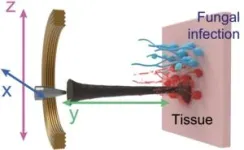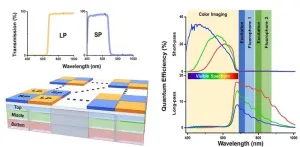(Press-News.org) University of Cincinnati researchers are presenting abstracts at the European Stroke Organization Conference (ESOC) 2023, May 24-26 in Munich, Germany, including the results of the first large-scale assessment of radiological brain health in stroke patients in a population.
Extensive research has helped pinpoint risk factors for initial stroke, but there is limited understanding about what the brains of stroke patients look like on a population level, according to UC’s Achala Vagal, MD, professor of neuroradiology.
“Imaging can be an objective manifestation of the presence and severity of clinical factors such as diabetes, hypertension, high cholesterol and kidney failure,” she said. “However, the majority of the large epidemiological studies of brain health have been performed in stroke-free subjects.”
Vagal was a co-principal investigator on the Assessing Population-based Radiological brain health in Stroke Epidemiology (APRISE) study that gained new information from neuroimaging results of stroke patients.
The research team analyzed all available clinical imaging data from nearly 3,500 patients who had a stroke in the Greater Cincinnati/Northern Kentucky region in 2015, assessing the imaging for signs of small vessel disease in the brain in the form of previous injury, microbleeds, white matter disease (wearing away of tissue) or brain atrophy, among other observations.
Vagal said the team identified three distinct clusters of observable imaging characteristics that were each associated with a specific set of clinical variables.
“This can help us understand the biology of preexisting brain health in stroke patients and help guide future interventions,” she said. “We expected all the imaging parameters of brain health due to small vessel disease to be closely clustered, but we found a lack of clustering of microbleeds with white matter disease.”
With the knowledge gained from the study, Vagal said the team is now using the brain health imaging data to build a prediction model of recurrent stroke.
“Such large-scale characterization of preexisting brain health is helpful to identify novel observable characteristics which can guide further studies,” she said.
Vagal presented the oral abstract “Radiological Phenotypes of Brain Health in a Stroke Population: Primary Results of the Assessing Population-Based Radiological Brain Health in Stroke Epidemiology (APRISE) Study'' during the Imaging scientific communication session Thursday, May 25.
Other abstract co-authors include UC’s Heidi Sucharew, Vivek Khandwala, Lily Wang, Rebecca Cornelius, Mary Gaskill-Shipley, Thomas Tomsick, Shantala Gangatirkar, Brady Williamson, Thomas Maloney, Mary Haverbusch, Janice Carrozzella, Kathy Alwell, David Robinson, Robert Stanton and co-principal investigators Pooja Khatri, MD, and Brett Kissela, MD; Paul Horn of Cincinnati Children’s Hospital Medical Center; David Wang of the I-MED Radiology Network in Melbourne, Australia; and Dawn O. Kleindorfer of the University of Michigan.
Other presentations from UC researchers include:
Felipe Ayala, “Collateral Grade as a Mediator of the Effect of Post-Endovascular Blood Pressure Goals on Outcomes: A Pre-specified Exploratory Analysis of the BEST-2 Randomized Trial,” during the Late Breaking Moderated poster session Thursday, May 25.
Joseph Broderick, “RFVIIA for Acute Hemorrhagic Stroke Administered at Earliest Time (FASTEST) Trial,” during the Ongoing Trials poster session Thursday, May 25.
Destiny Hooper, “Diffusion-Weighted Image Positivity Predicts Three-Year Risk of Stroke or Death After Transient Ischemic Attack in Biracial Population,” Wednesday, May 24.
Hooper, “Elevated Leukocyte Counts Are Associated With Worse Functional Outcomes in Patients with Large Vessel Occlusion,” during the Prognosis and Outcome After Stroke poster session May 25.
Pooja Khatri, “Ischemic Stroke with Minor Disabling Deficit,” during the Improving Outcomes of Acute Reperfusion Therapies for Acute Ischemic Stroke scientific session May 26. END
Study finds distinct patterns of pre-existing brain health characteristics in stroke patients
University of Cincinnati stroke researchers present at international conference
2023-05-26
ELSE PRESS RELEASES FROM THIS DATE:
Nanorobotic system presents new options for targeting fungal infections
2023-05-26
Infections caused by fungi, such as Candida albicans, pose a significant global health risk due to their resistance to existing treatments, so much so that the World Health Organization has highlighted this as a priority issue.
Although nanomaterials show promise as antifungal agents, current iterations lack the potency and specificity needed for quick and targeted treatment, leading to prolonged treatment times and potential off-target effects and drug resistance.
Now, in a groundbreaking development with far-reaching implications for global ...
Bird brains can flick switch to perceive Earth’s magnetic field
2023-05-26
Earth’s magnetic field, generated by the flow of molten iron in the planet’s inner core, extends out into space and protects us from cosmic radiation emitted by the Sun. It is also, remarkably, used by animals like salmon, sea turtles and migratory birds for navigation.
But how? And why? A new study from researchers at Western’s Advanced Facility for Avian Research (AFAR), home to the world’s first hypobaric climatic wind tunnel for bird flight, explores a brain region called cluster N that migratory birds use to perceive Earth’s magnetic field. The team discovered the region is activated very ...
Food for thought: UH study highlights the role of clean technology in reducing food waste
2023-05-26
Foodservice companies have long struggled with the challenge of what to do with all of their food waste. But researchers at the University of Houston Conrad N. Hilton College of Global Hospitality Leadership are shedding light on how clean technology can help those companies reduce waste and establish long-term sustainability goals.
In a study published in the Journal of Hospitality & Tourism Research, Tiffany S. Legendre, an associate professor at Hilton College, and her team, interviewed 17 leaders of the country’s largest on-site foodservice providers (e.g., Aramark, Compass and Sodexo), ...
Illinois Tech announced as enrollment partner in NIH’s AI precision nutrition research, largest project of its kind
2023-05-26
CHICAGO—May 26, 2023—Illinois Institute of Technology is one of 14 institutions chosen as an enrollment site for the National Institute of Health’s landmark initiative to advance nutrition research. Nutrition for Precision Health (NPH), powered by the All of Us Research Program, is working to engage 10,000 participants from diverse backgrounds across the United States with the aim of learning about how our bodies respond differently to food.
NPH will use artificial intelligence–based ...
World leader in photonics gives talk at Aston University
2023-05-26
Talk by one of the leading lights in optical communications
Dr. Ming-Jun Li is currently a corporate fellow at Corning Incorporated
He discussed installed optical fibres for ultra-wideband transmission systems.
26 May 2023 | Birmingham, UK
Aston University has hosted one of the leading lights in optical communications and speciality optical fibres at its second international photonics workshop.
Dr. Ming-Jun Li is currently a corporate fellow at Corning Incorporated in the USA and headed ...
GPS tracking reveals how a female baboon stopped using urban space after giving birth
2023-05-26
A new study from Swansea University and the University of Cape Town provides the first documented evidence of a cessation in urban space use by a female baboon after giving birth: another example of how wild animals are adaptively responding to urbanisation.
The study, recently published in the journal Ecology & Evolution, used GPS collars to track the movements of 13 chacma baboons in Cape Town, South Africa.
The data revealed that when one collared female gave birth, she stopped using urban space without any significant change in daily distance travelled or social interactions that would be expected with general risk-sensitive behaviour during this ...
Tree islands bring biodiversity to oil palm plantations
2023-05-26
Islands of trees in oil palm plantations can significantly increase biodiversity within five years without reducing productivity. This has been shown by an experiment, which has been running for over ten years in Indonesia as part of the Collaborative Research Centre (CRC) "EFForTS" at the University of Göttingen. An international team of researchers led by Göttingen planted experimental islands of trees in plantations on the island of Sumatra to counteract the species loss caused by the ...
Innovative endoscopic imaging system can detect multiple fluorescent tracers
2023-05-26
For patients with solid cancers, endoscopic surgery is one of the primary treatment options to remove tumors. However, there is a high risk of cancer recurrence if even a small number of cancerous cells are left behind after surgical resection. To prevent this from happening, researchers developed fluorescence-guided surgery (FGS). In FGS, patients are injected with a fluorescent probe that preferentially binds to tumor cells, enabling surgeons to easily identify lesions with the help of specialized endoscopes that emit the necessary excitation light.
Unfortunately, tumors can be highly heterogeneous, ...
CHOP researchers show that IgA fine tunes the body’s interactions with microbes
2023-05-26
Philadelphia, May 26, 2023—IgA deficiency is the most common primary immune deficiency worldwide, but its presentation has puzzled physcians and researchers. Some with the disorder present with symptoms like recurrent infections, autoimmune disease, or allergies, whereas others have no symptoms at all and only become aware of their IgA-deficient status through an incidental finding on a blood test. This variability has raised the question among researchers: Why aren’t many of those with IgA deficiency sicker?
A new study by researchers at Children’s ...
Protein-based nano-‘computer’ evolves in ability to influence cell behavior
2023-05-26
HERSHEY, Pa. — The first protein-based nano-computing agent that functions as a circuit has been created by Penn State researchers. The milestone puts them one step closer to developing next-generation cell-based therapies to treat diseases like diabetes and cancer.
Traditional synthetic biology approaches for cell-based therapies, such as ones that destroy cancer cells or encourage tissue regeneration after injury, rely on the expression or suppression of proteins that produce a desired action within a cell. This approach can take time (for proteins ...
LAST 30 PRESS RELEASES:
Sleeping in on weekends may help boost teens’ mental health
Study: Teens use cellphones for an hour a day at school
After more than two years of war, Palestinian children are hungry, denied education and “like the living dead”
The untold story of life with Prader-Willi syndrome - according to the siblings who live it
How the parasite that ‘gave up sex’ found more hosts – and why its victory won’t last
When is it time to jump? The boiling frog problem of AI use in physics education
Twitter data reveals partisan divide in understanding why pollen season's getting worse
AI is quick but risky for updating old software
Revolutionizing biosecurity: new multi-omics framework to transform invasive species management
From ancient herb to modern medicine: new review unveils the multi-targeted healing potential of Borago officinalis
Building a global scientific community: Biological Diversity Journal announces dual recruitment of Editorial Board and Youth Editorial Board members
Microbes that break down antibiotics help protect ecosystems under drug pollution
Smart biochar that remembers pollutants offers a new way to clean water and recycle biomass
Rice genes matter more than domestication in shaping plant microbiomes
Ticking time bomb: Some farmers report as many as 70 tick encounters over a 6-month period
Turning garden and crop waste into plastics
Scientists discover ‘platypus galaxies’ in the early universe
Seeing thyroid cancer in a new light: when AI meets label-free imaging in the operating room
Neutrophil-to-lymphocyte ratio may aid risk stratification in depressive disorder
2026 Seismological Society of America Annual Meeting
AI-powered ECG analysis offers promising path for early detection of chronic obstructive pulmonary disease, says Mount Sinai researchers
GIMM uncovers flaws in lab-grown heart cells and paves the way for improved treatments
Cracking the evolutionary code of sleep
Medications could help the aging brain cope with surgery, memory impairment
Back pain linked to worse sleep years later in men over 65, according to study
CDC urges ‘shared decision-making’ on some childhood vaccines; many unclear about what that means
New research finds that an ‘equal treatment’ approach to economic opportunity advertising can backfire
Researchers create shape-shifting, self-navigating microparticles
Science army mobilizes to map US soil microbiome
Researchers develop new tools to turn grain crops into biosensors
[Press-News.org] Study finds distinct patterns of pre-existing brain health characteristics in stroke patientsUniversity of Cincinnati stroke researchers present at international conference








